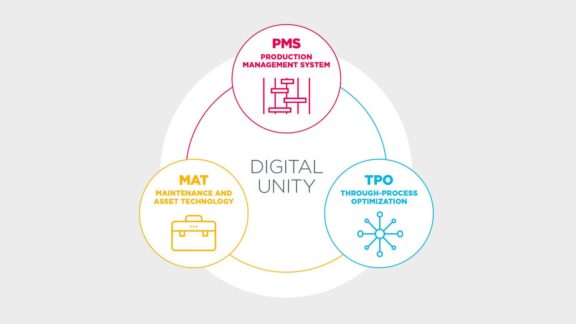Maintenance and Asset Technology (MAT) from Primetals Technologies is a system for the intelligent management of all maintenance-related assets, and can do much more than cost tracking and maintenance scheduling. By applying Industry 4.0 principles to maintenance management, MAT delivers intelligence that transforms maintenance activities from a burdensome cost factor into a strategic advantage for more effective plant operations.
Supporting production
The ultimate goal of maintenance management is not to perform maintenance for its own sake—its purpose is to support production. Great maintenance reduces risk and improves performance. Its benefits must continuously be balanced against the costs of personnel, materials and above all lost productivity. Plant maintenance today is often managed in a fairly traditional manner, as a cost center focused on staying on budget. Maintenance strategies are often reactive, or based on simple time intervals that were put in place based on the opinion of technicians. Condition monitoring may be in place, but often without a clear goal. Computerized maintenance management systems (CMMS), when implemented, tend to concentrate on tracking and data archiving.
Meanwhile, due to increased cost pressure, plant maintenance teams face significant efficiency challenges. Resources—men, materials and machines—must be organized for highest productivity. However, in the dynamic 24/7 environment of a steel mill where every minute of downtime is costly, priorities can change fast, and the maintenance staff has to respond with the same speed. Standard enterprise resource planning software is not flexible enough and lacks domain expertise for decision-making support; changes can impact orders for weeks to come, requiring tedious rescheduling routines.
Rise of the “smart factory”
Fortunately, the rise of the Industry 4.0 “smart factory” provides a great opportunity to improve maintenance management. Now, plants and IT systems can talk to one another. Condition monitoring information can lead to maintenance suggestions in MAT and ensure that no important alarm is left unattended. Production planning, quality management, through-process optimization and maintenance/asset management can be connected to exchange information. MAT provides all of the Industry 4.0 intelligence needed for a highly flexible maintenance execution. Advanced visual scheduling makes the best use of both personnel and equipment, ensuring efficient planning with minimal production impact so that changes and their consequences can be easily understood.
Modular architecture
Four smart modular packages—Predictive Maintenance, Planning & Shutdown Optimizer, Reporting & Business Intelligence, Strategic Asset Management—provide intelligence and domain expertise and help customers step by step toward world-class maintenance. With decades of industry-specific experience behind it, MAT can come pre-loaded with everything from criticality assessments and maintenance strategies for specific equipment, to procedures, documentation and checklists for responding to specific alarms.
Furthermore, with MAT, the wealth of data available from your plant coupled with industry-specific expertise from Primetals Technologies, can transform tedious maintenance routines into a smart asset management program. Maintenance decisions can be made strategically and dynamically, based on data gathered from both condition monitoring and manual inspection. Instead of sifting through multiple data stores, with a single click the workshop can have access to the full history of a particular piece of equipment to understand how often the asset needed repair, which parts were changed, which improvements were implemented. Through data analytics, maintenance needs can be predicted and planned, and the focus can shift to creating value, reducing total cost of ownership, and increasing productivity.
Gaining competitive advantage
Before you can even ask, MAT answers questions such as: What must be done when a specific alarm goes off? On what basis (time, usage, wear, etc.) should you maintain a specific asset, or should you simply wait until it fails? Can you postpone an inspection until after the next big order? Can a different material be produced until an equipment problem is resolved? Which preventive maintenance procedures are worth implementing and which are not? What investments in condition monitoring bring the greatest return? What conditions or products are associated with the most downtime? What maintenance procedures extend equipment lifespan? With MAT, such information is easily gained and the associated processes are streamlined—MAT is a must for everyone involved in a steel plant’s maintenance efforts, and key in gaining a competitive advantage.

Interview with
Paulo Marinho
Paulo Marinho is Head of Operations at Primetals Technologies’ workshop in Rio de Janeiro, Brazil. The site is located in the vicinity of the facilities of Ternium Brazil (formerly thyssenkrupp CSA). In 2009, the workshop started to provide metals producers with online and offline maintenance for the whole steel mill, including segments repair for continuous casting machines and roll refurbishment, as well as nickel plating for the molds. Marinho has overseen the on-site implementation of the Maintenance and Asset Technology (MAT) system of Primetals Technologies in his workshop, and participated in fine-tuning the system to meet the needs at hand.
How long have you been using MAT?
Marinho: We started the project in December of 2016 as a cooperation between our staff at the Rio de Janeiro workshop and our Metallurgical Services headquarters in Linz, Austria. Since then, we have thoroughly tested MAT’s features. It has been a great product launch, and despite the steep learning curve we were able to meet the expectations of everyone involved.
Has MAT made your life—and that of your staff—easier, and how?
Marinho: We need to be more and more digital and get information from the workshop automatically in order to direct our resources to the activities that add the most value. MAT allows us to generate automatic reports that previously took us several hours to compile. The scheduling of workshop activities using visual tools makes it easier and faster to provide feedback to customers. It also makes it simple to eliminate any bottlenecks. The entire staff is very enthusiastic about the implementation of MAT, because they understand the need to work smarter instead of working physically harder.
Is there any one functionality of MAT that you particularly like?
Marinho: I am a huge fan of the equipment-history functionality, as this offers us the opportunity for developing better solutions for our customers. This feature analyzes the performance and all kinds of influences during equipment operation, and therefore helps to implement improvements that reduce overall maintenance costs and production downtime.
Who would you recommend MAT to?
Marinho: I recommend MAT to every company wanting to optimize their service resources by increasing equipment lifetime. The knowledge base generated through the use of MAT is very powerful and can surely bring companies a competitive advantage.

